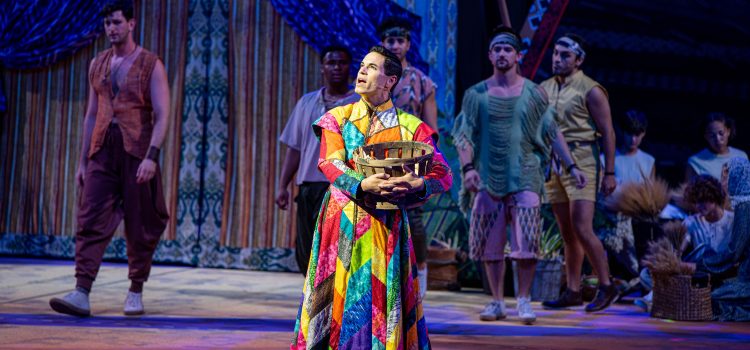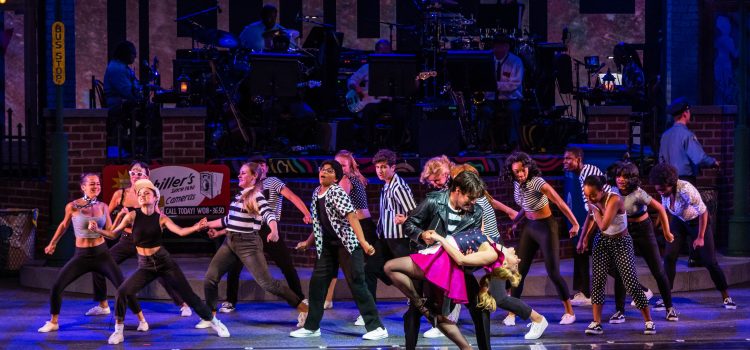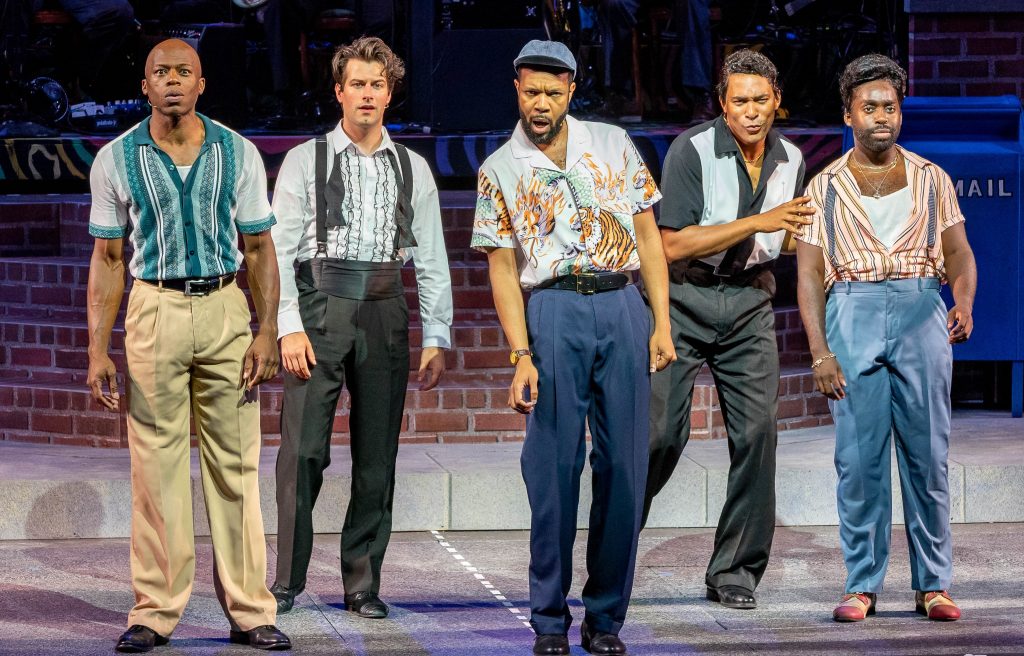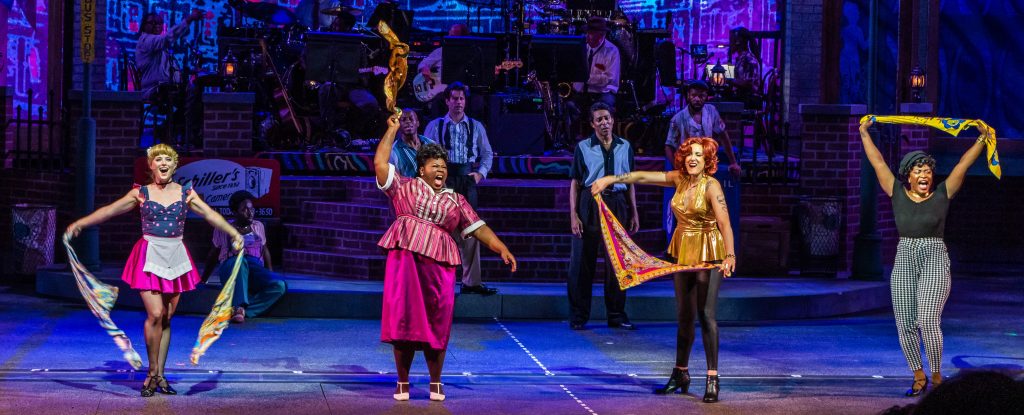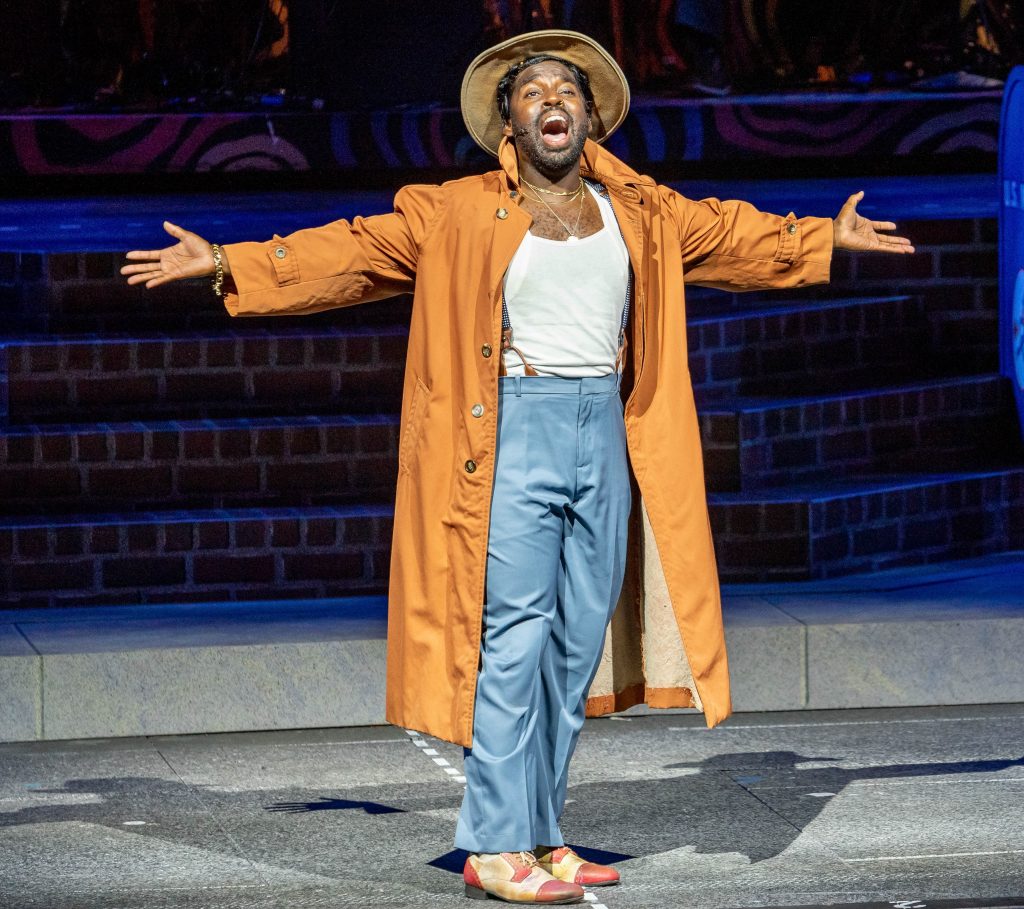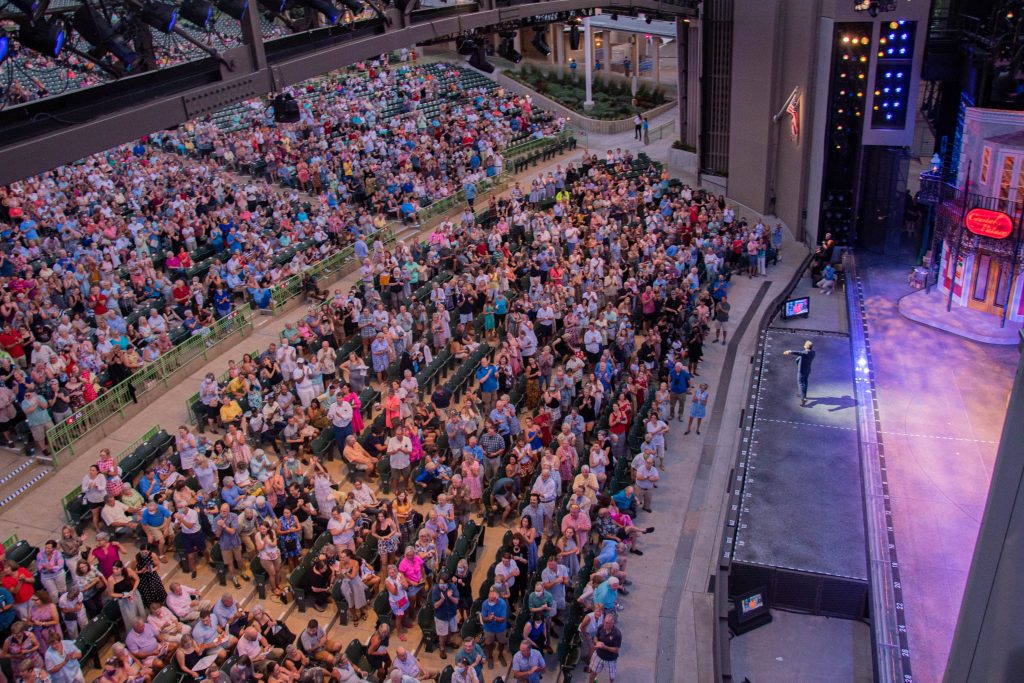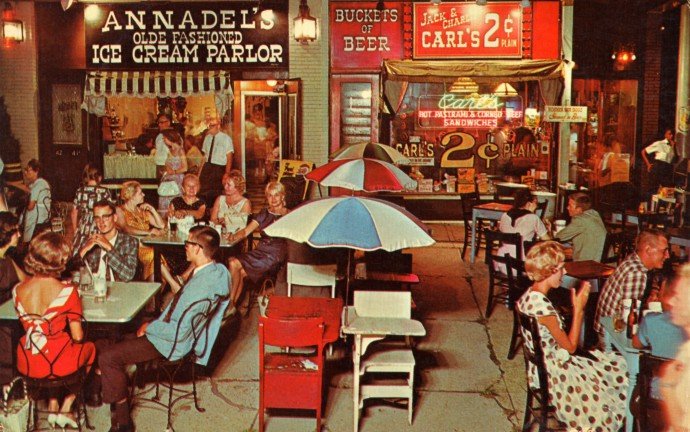By Lynn Venhaus
As frothy as a cappuccino and sweet as cotton candy, “Joseph and the Amazing Technicolor Dreamcoat” took hold of The Muny stage as a swirling kaleidoscope of color, a glittery burst of cheer from a youthful ensemble that brings it home.
In the first full season after the challenging post-pandemic years 2020-2021, The Muny wraps up a groundbreaking summer with this beloved big, splashy musical that has been here six times. Last produced in 2012, the show first arrived in 1986 and returned in 1997, 2002 and 2007.
With its technical razzle-dazzle matched by the effervescent Muny Kids and Teens in the youth ensemble and children’s choir, the entire company looked like they were at the happiest place on earth.
That engaged the crowd, and the charismatic principals Jason Gotay as golden child Joseph, Jessica Vosk as the regal Narrator, and Mykal Kilgore as the swaggering Pharoah elevated the wispy material, delivering knock-out performances.
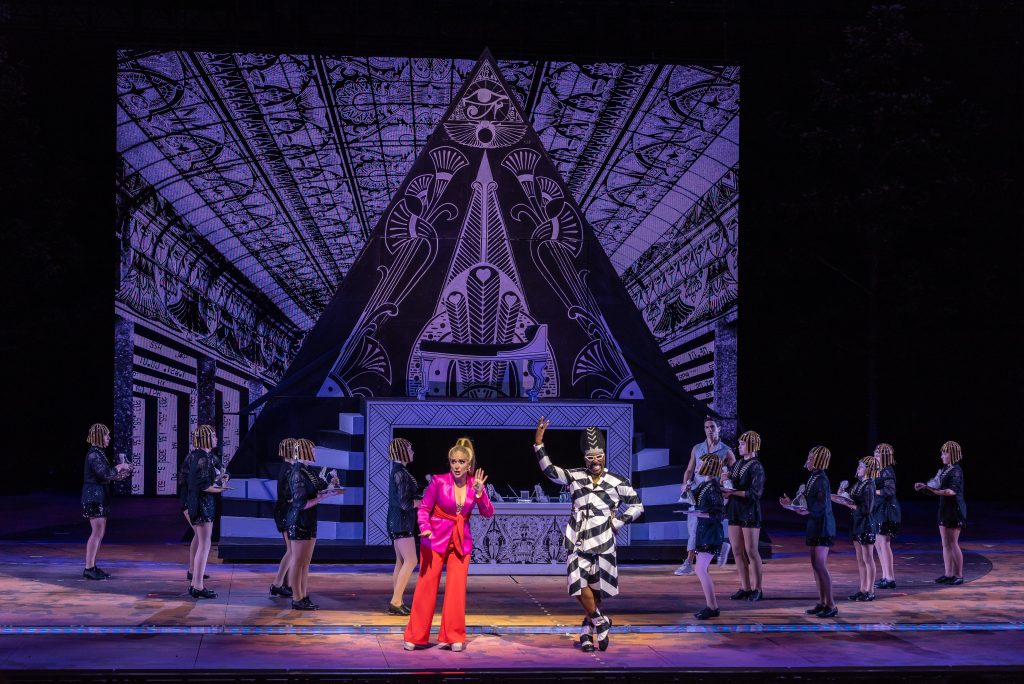
However, the show is not without heartache and adversity – with a turnaround because of strength, perseverance, and blessings, for it is based on the Old Testament Book of Genesis tale of Jacob, his favorite son Joseph, his 11 other sons, and that famous coat of many colors.
After Joseph’s jealous brothers sell him into slavery, he impresses the Egyptian noble Potiphar, but then rejects his wife’s amorous advances, and is thrown in jail. While locked up, Joseph’s talent for interpreting dreams is put to good use. He ingratiates himself with the Pharoah because he offers a solution to the country’s famine, and that stroke of fortune results in Joseph becoming the Pharoah’s right-hand man. He is eventually reunited with his family.
In the stylized re-imagining by composer Andrew Lloyd Webber and lyricist Tim Rice, the story is told through song and dance.
Considered innovative in the 1970s, the musical comedy has expanded over time, and is now regarded as a family-friendly favorite staged by thousands of schools and groups in the U.S. and across the pond.
The EGOT duo began this journey collaborating for the second time in 1968. Commissioned by a music teacher who was a family friend of Webber’s, their 15-minute pop cantata was performed at the Colet Court School in London. After more tinkering, it was recorded by Decca Records in 1969.
When their next piece, the rock opera “Jesus Christ Superstar,” skyrocketed them to fame in 1971, the earlier musical was stretched to 35 minutes for the Edinburgh International Festival the next year. More modifications followed, and the modern format was staged in 1974. It was mounted on Broadway in 1982 and nominated for seven Tony Awards. Revivals, tours and a 1999 direct-to-video film starred Donny Osmond followed.
Like the other pop Biblical musical of that era, Stephen Schwartz’s “Godspell,” it is re-interpreted for every presentation. Consider this the theme park ride version, with the youngsters displaying as much energy as those attending summer cheerleading camps.
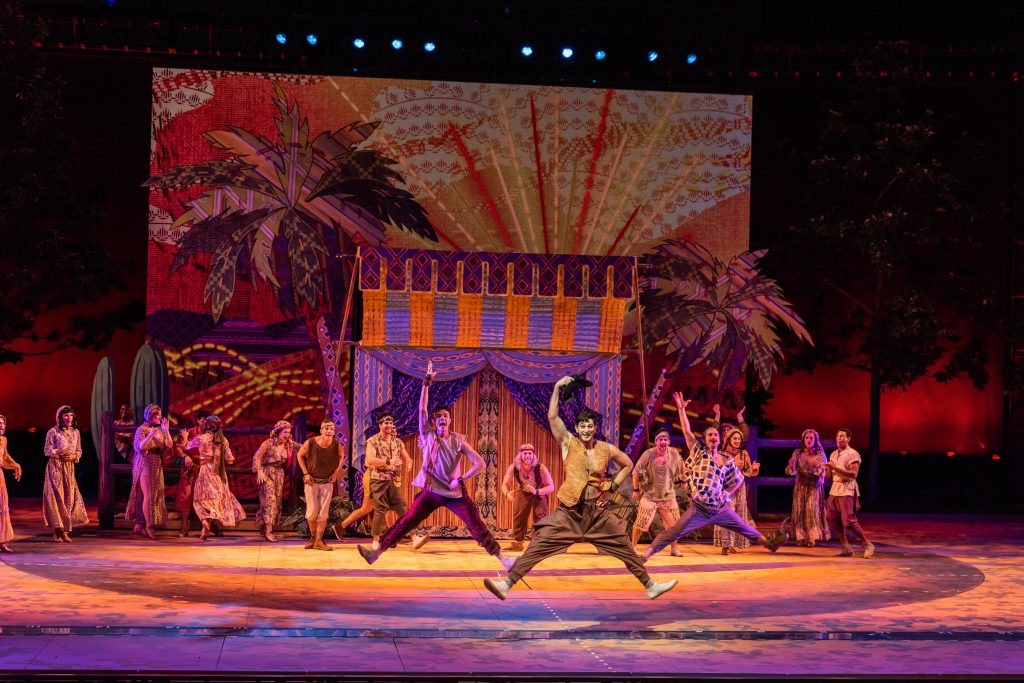
It’s a swell dance party, briskly performed in several celebratory scenes and elaborate pastiches – including countrified “One More Angel in Heaven/Hoedown,” the French-inspired lament “Those Canaan Days,” island-flavored “Benjamin Calypso” and the grandmaster flashy finale “Megamix.”
The pleasant pop-py tunes “Any Dream Will Do” and “Go, Go, Go Joseph.” are certain to be hummable on your way home.
Music director Charlie Alterman, who won last year’s St Louis Theater Circle Award for “Chicago,” is adept at lively shows with many moving parts and his orchestras are a treat to listen to — and he’s aware of the Muny’s pit challenges this season.
Of course, a show directed and choreographed by Josh Rhodes would seize the day. Rhodes, who is known for his athletic and acrobatic dances, returns after successes helming “Jersey Boys,” “Paint Your Wagon” and that stunning tap number to “Putting on the Ritz” in 2016’s “Young Frankenstein.”
This is a show that requires a special set of skills, and Rhodes’ crisp and snappy choreography is flat-out fun. He was aided by associate choreographer Lee Wilkins and dance captain Emilie Renier.
In its last national tour in 2014, the ingenious three-time Tony Award winner Andy Blankenbuehler directed and choreographed a fresh interpretation that ran at the Fox Theatre that spring. That show featured American Idol finalist Ace Young as Joseph and his wife, fellow finalist Diana DeGarmo, as the Narrator.
The role of Joseph is often filled by a pop star – and teen heartthrobs David Cassidy, Andy Gibb and Donny Osmond have played the lead before. (And first American Idol runner-up Justin Guarini, who has played various roles at the Muny, was Joseph in 2012.)
At the Muny, Jason Gotay has won over hearts as a charming leading man, appearing as Prince Eric in “The Little Mermaid,” Prince Topher in “Rodgers + Hammerstein’s Cinderella” and as Jack in “Into the Woods.”
His strong velvety vocals emphasize he is no lightweight, heart-tugging in “Close Every Door.” He commands the stage confidently, capably leading the large cast in the group numbers.
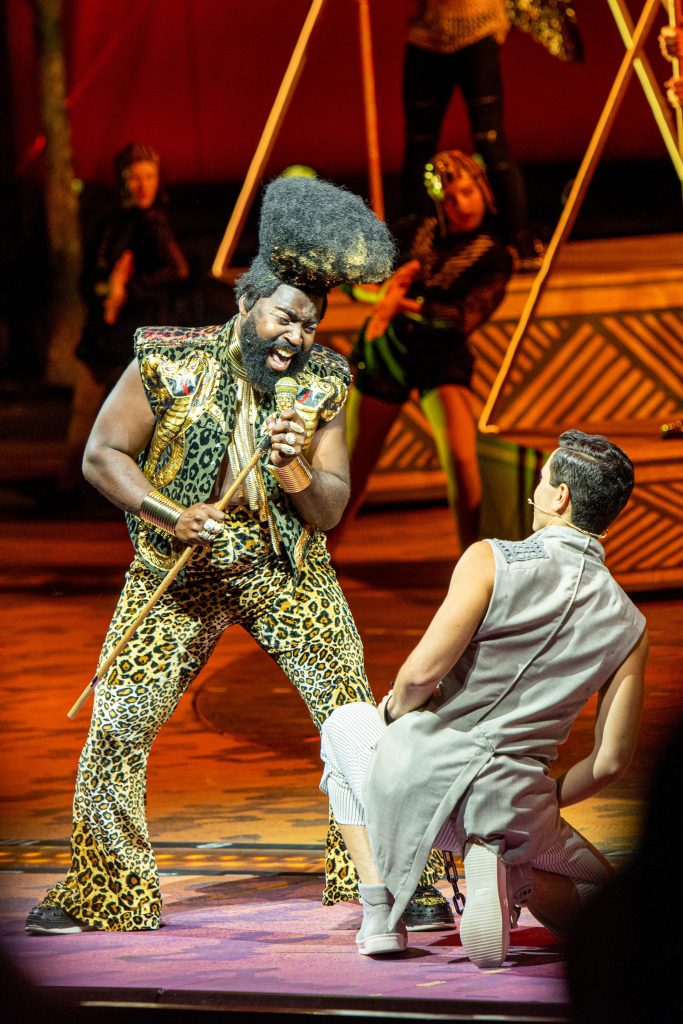
However, the showstopper in this production is Mykal Kilgore.
One of my favorites since I saw him at the Muny Magic concert at the Sheldon in 2017, the affable Kilgore slays as the megawatt Pharoah. It’s as if James Brown and Little Richard had a baby.
In a departure from the previous Elvis-like personas, Kilgore reaches back to his R&B roots for “Song of the King,” bringing the house down. The Pharoah’s stage time is brief, but his impact is mighty.
Jessica Vosk makes her Muny debut, playing a hands-on narrator who just doesn’t just observe the action from the sidelines, but propels it along. Here, she is a surrogate mother hen to the youngsters as she tells the tale.
Vosk has the powerful pipes to fill an arena and is well-suited for this grand production. She has played the role before, in the 50th anniversary show at the Lincoln Center, and is remarkably assured while the action bubbles up around her.
Other noteworthy debuts are multi-hyphenate Eric Jordan Young in the dual role of well-meaning Jacob and flamboyant Potiphar, and Darron Hayes as playful Judah, who takes the lead in “Benjamin Calypso.”
The adult choir is chock-full of Muny regulars, and some familiar castmates are playing brothers. Dynamic Harris Milgrim, a standout as Benjamin in last year’s “Seven Brides for Seven Brothers,” is again as Reuben in “One More Angel.”
Sean Ewing, in his third season at the Muny, is second son Simeon, amusing in “Old Canaan Days.”
Not all the hijinks work, for the mashups often are silly, and the gaudy pageantry can easily slide into trivial frivolity, but that’s the problem with the show itself. As the years ago on, they keep gilding the lily, adding more to an already over-the-top show. But it remains a huge crowd-pleaser.
And the joyous look on those kids’ faces on stage said it all. (I counted 40 in the youth ensemble and 14 in the children’s choir, in addition to the 19 in ensemble, not to mention principals.)
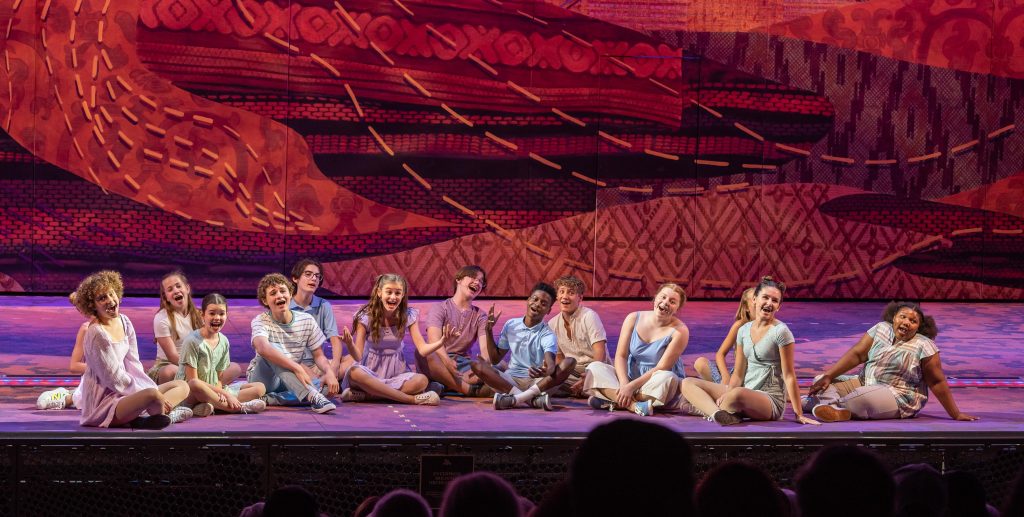
Edward E. Haynes Jr., the award-winning scenic designer for “Smokey Joe’s Café” last year, combines glitz, a Skittles rainbow of bold colors, and Egyptian symbols for the second act, in a whimsical set reminiscent of Tim Burton and the Marvel superheroes’ cinematic universe.
In a stunning backdrop, he references King Tutankhamen’s gold headdress in a giant piece anchoring a fancy staircase with neon piping..
Video designer Greg Emetaz is in sync with Haynes’ vision, and an extension of the gold-plated theme uniting the looks is on the LED screens.
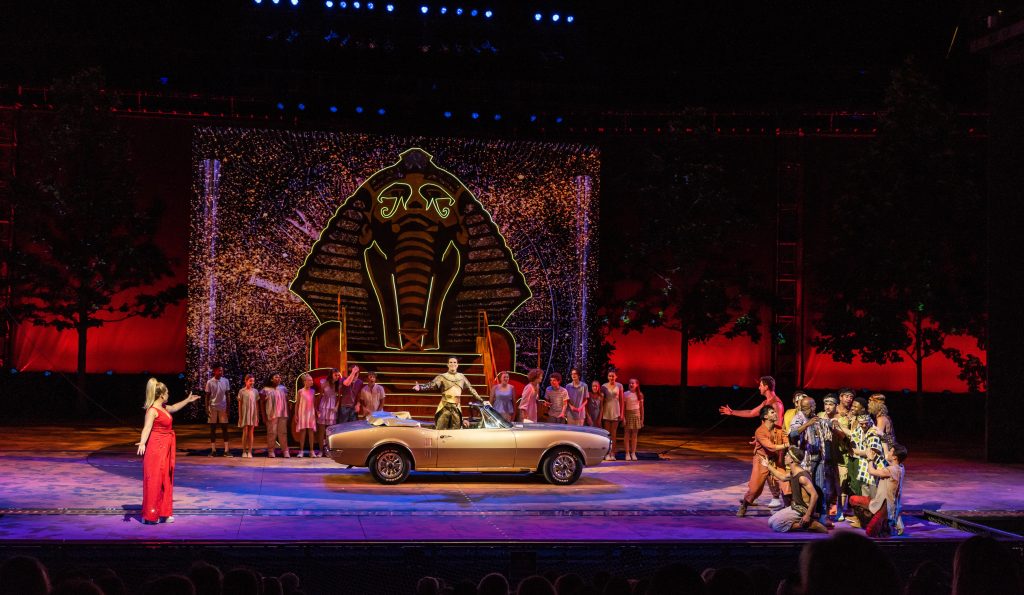
Costume designer Leon Dobkowski references Vegas showgirls, exotic images and B.C. looks to create sparkly outfits and a sunny vibe. His elaborate headdresses are something special to see. The different gold fabrics stand out in garments, and kudos to wig designer Kelly Jordan for the Pharoah’s massive ‘do.
Jason Lyons’ lighting design capitalizes on the wonder and magical parts, and smartly ascertains between the dreamy sequences and the dark times.
It’s fitting that The Muny focused on home, family, relying on each other and connection for the last show of the 104th season, particularly after what they endured from mid-June to now with the double-whammy of back-to-back floods, extreme heat – even by St. Louis standards (oh you layered Edwardian Londoners in “Mary Poppins”!), and a new strain of COVID-19 on the rise in the region (but thanks to understudies and swings, the shows went on).
In his annual farewell address, Mike Isaacson, executive producer and artistic director since 2011, joked that the season was ‘biblical,’ and who could argue?
Known for its fizzy fun, “Joseph” delivered a spectacle to end the season on a high-spirited note.
If you think of the Muny in terms of a summer vacation, “Chicago” was nightlife fun, “Camelot” was a Renaissance Faire, “Mary Poppins” was a trip to the Magic House, “Legally Blonde” was a class reunion, “Sweeney Todd” was visiting the Louvre, “The Color Purple” was the Smithsonian and “Joseph and the Amazing Technicolor Dreamcoat” was a trip to Disneyland.
Until we meet again under the stars in Forest Park, here’s raising a glass to a summer tradition that I am grateful for, and will never ever take for granted.

The Muny presents the musical “Joseph and The Amazing Technicolor Dreamcoat” Aug.13-18 at 8:15 pm. Performances take place on the outdoor stage in Forest Park. For more information, visit www. muny.org.
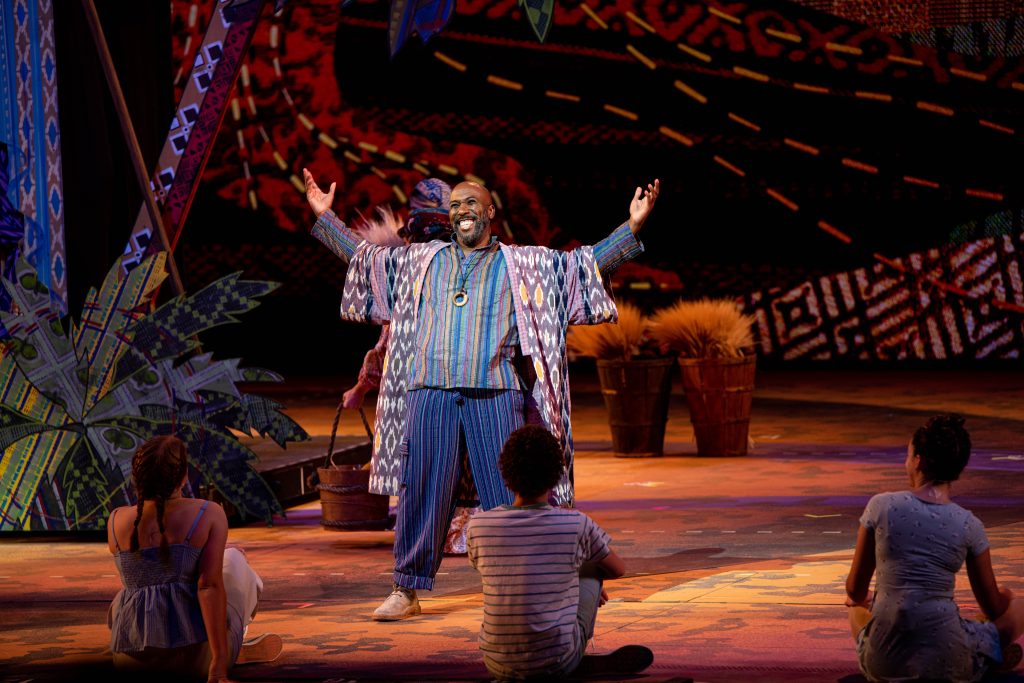

Lynn (Zipfel) Venhaus has had a continuous byline in St. Louis metro region publications since 1978. She writes features and news for Belleville News-Democrat and contributes to St. Louis magazine and other publications.
She is a Rotten Tomatoes-approved film critic, currently reviews films for Webster-Kirkwood Times and KTRS Radio, covers entertainment for PopLifeSTL.com and co-hosts podcast PopLifeSTL.com…Presents.
She is a member of Critics Choice Association, where she serves on the women’s and marketing committees; Alliance of Women Film Journalists; and on the board of the St. Louis Film Critics Association. She is a founding and board member of the St. Louis Theater Circle.
She is retired from teaching journalism/media as an adjunct college instructor.

